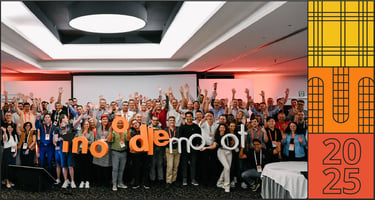When we started brainstorming the theme for MoodleMoot Global this year, a lot of related ideas...
What does accessibility really mean?
What does accessibility really mean? A look back at MoodleMoot talks on designing for the margins
“Disability can be episodic, temporary, or situational. So can accessibility needs.”
When presenting on his topic, ‘Designing Moodle for Accessibility’, Brett Dalton told us several stories about learners with multiple learning preferences. For example, a learner suffering from anxiety might find a particular type of course harder to grasp than others. Or how long-scrolling content can be more than just boredom, and it often overwhelms learners more than it helps.
Brett’s talk at last year’s MoodleMoot Global expanded a lot on what we perceive as disability. While the standard belief limits disability to permanent or visible conditions, we forget that disability is a spectrum that can also be temporary, episodic, and entirely shaped by context and environment.
A clear example of this was set by Javier Tejera, from Alma Children’s Education Foundation, who talked about learning spaces in rural Peru. The educators, who lived and worked in isolated highlands, had little to no access to the internet. Sometimes they had to walk up and down the hills to get a clear signal, and often faced a power outage. They also had limited experience with digital tools, and some of them didn’t even have an email address. These educators lived far from any city or training centres, making traditional in-person professional development almost impossible.
In this kind of scenario, accessibility isn’t just about addressing the visible needs; it is rather about ensuring that everyone has access to the basic amenities for education.
Principles in practice from the Peruvian highlands
Alma Children’s Education Foundation partnered with a university in Lima to create an accredited diploma program designed with accessibility at its core. The entire course was accessible via a branded Moodle mobile app. But “mobile-first” meant more than just screen responsiveness. It meant designing for spatial mobility, understanding that some learners could only access the internet at certain locations or times, and tailoring content to accommodate that.
They maintained a flexible, asynchronous structure. Recognising that some teachers could only access the internet once a month, Alma removed rigid weekly schedules. Assignments and forums remained open longer, and the course calendar allowed for local disruptions such as power cuts or seasonal weather events.
The team prioritised minimal bandwidth demands, downloadable resources, and clear, simple navigation. Each cohort was guided by dedicated tutors who provided personalised support, sometimes helping teachers set up their first-ever email accounts.
This way, Alma was able to support around 355 rural educators to participate in the diploma program. Despite environmental barriers, there was reportedly no statistically significant performance difference between rural and urban participants. Some of the educators also claimed:
"For the first time, I felt the same as the teachers from urban schools. Everyone was treated equally."
Compliance is essential but not the end goal
Javier’s example is an obvious reminder that accessibility relies on the context. In his presentation, Brett also pointed out that,
"It’s not good policy to be triple-A compliant because everything is a compromise."
He emphasised that for every learner to be included in the lessons, the content should be available in alternative formats. This is something that we see happening in Alma’s “mobile-first” approach.
But more broadly, both Brett and Javier were pointing toward the same thing: that accessibility is about designing with empathy, not assumptions. It’s about recognising that your learners’ abilities, devices, internet access, time zones, and even emotional states are all part of the learning environment.
What can accessibility look like in a Moodle course?
At the platform level, Moodle has been making continuous improvements to ensure that every learner’s needs are met, down to the smallest details.
Brett’s presentation expanded on the five key features that are required and can be implemented to make any course accessible to learners with diverse learning preferences.
These include:
- Design for all learners – Accessibility isn’t only about permanent, visible impairments, as we stated earlier. Any accessible design should support temporary impairments, mental health fluctuations, and neurodivergent needs.
- Take a multi-modal approach – Accommodate every learner’s preferences through audio, video, and text-based content. One format does not fit all, which is why it’s important to provide downloadable files and offline access, as well as multilingual tools and read-aloud support, such as ReadSpeaker integration.
- Reduce distractions – Apply minimalistic design, which helps learners focus and reduce cognitive load. This is especially important for students with concentration challenges or in low bandwidth environments. A good way to do this is to limit content width and reflow content for smaller screens.
- Prioritise a clear and consistent interface – Especially in UI design. This will reduce confusion, a key factor for learners with cognitive or language barriers. Avoid using repeated words, long sentences, and double negatives. Instead, keep labels short, clear, and action-oriented.
- Involve people – Asking learners what they need (instead of assuming) is the first step towards creating accessible courses. Take into account every possible factor: for example, not every learner will have a laptop, access to fast internet or familiarity with tools. Conduct user research in diverse settings. Solutions must be context-aware and user-informed.
All of this adds up to a mindset shift that is baked into the learning design. It means designing for multiple realities: the teacher who learns on their commute, the student recovering from surgery, the learner who’s simply overwhelmed by a cluttered screen.
You can learn more about the best practices of designing courses on Moodle for accessibility in Brett’s presentation.
Curious for more?
The Moodle community has a lot to offer. Whether it is to do with accessibility, learning design, EdTech insights, or discussions about the future of learning, there are always so many new ideas to explore.
And MoodleMoot Global is just the right place for that.

